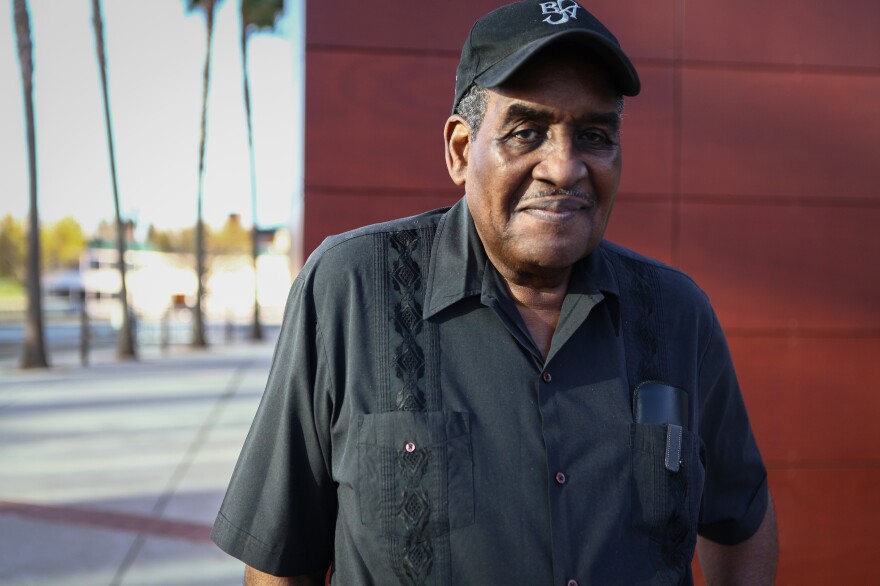When the National Museum of African American History and Culture opens to the public on Saturday afternoon, there will be a lot of artifacts on display — everything from Frederick Douglass' formal portrait to a shiny, cherry-red Cadillac convertible that R&B king Chuck Berry once drove onstage. There will also be parts of hidden African American history that are, for many, being made visible for the first time. That's where Willie Harris comes in.
Harris is president of the Black Stuntmen's Association (BSA), which formed in 1967 to give black men and women a shot at the lucrative and, in some ways, glamorous Hollywood jobs that involved jumping from trains or rolling down stairs; jobs that were once reserved for white people.
Some of the original stuntmen have died, but through Harris and others, their stories will join those of other black pioneers in the newest museum to open on the National Mall. Dwandalyn Reece, curator of Music and Performing Arts at the museum, said she thought it was important to include people in all parts of the entertainment industry.
"We're not just interested in people in front of the camera or on the stage," she said. "Part of that story is the people who were behind the scenes, and what they've accomplished in the field."
Harris and other stuntmen and women launched their careers at a time when Hollywood engaged in the lamentable practice of "painting down" white men and women so they could be the stunt doubles for black actors. That practice was first challenged by actor and comedian Bill Cosby at the height of his successful 1960s action-adventure TV series, "I Spy." Cosby told the show's producers, Harris recalled, that "'no white guy is going to double me painted down.' "
I thought out West would be different. But in a whole lot of ways, it wasn't.
Calvin Brown became the country's first black stuntman when he got the job as Cosby's double. But Harris wasn't far behind. A mutual friend introduced the two men, and soon Harris was working as an extra and not long after that, doing stunts. His first big break was a long roll down concrete steps in the 1971 movie "Dirty Harry."
As a young Air Force veteran, Harris left his birthplace in Holmes County, Miss. because he was no longer willing to suffer the myriad indignities segregation visited upon black people. He didn't find Hollywood much more welcoming.
"I thought out West would be different," he said. "But in a whole lot of ways, it wasn't."
In the beginning, white stuntmen had no interest in sharing secrets of the trade with black men or women, Harris said. And black stuntmen were barred from the training academies that taught skills that would keep them safe. So Harris and his colleagues taught themselves.
Eventually, political pressure and common sense curtailed the practice of painting down, but apparently didn't end it. Nonie Robinson, whose grandfather, Ernie, was one of the first black stuntmen and an early BSA member, told NPR in 2015 that the problem hadn't so much gone away as it had gone underground.
Their activities behind the scenes opened the doors for other people behind the scenes — regardless of what field you're in.
"It's Hollywood's dirty little secret," she said. "It's still happening today."
Robinson produced a documentary about BSA called Painted Down, which will be released next year.
Visitors to the National Museum of African American History and Culture will see some of the props the stuntmen used in their movies, along with photos of people like Jadie David, who did stunts for actress Pam Grier in Grier's "Blaxploitation" heyday.
The stuntmen's contributions went beyond their physical skill, says Reece, the museum curator.
"Their activities behind the scenes opened the doors for other people behind the scenes — regardless of what field you're in," she said. "So they were the forefathers and foremothers in opening avenues for African Americans in all walks of life in the entertainment industry."
What the pioneer stuntmen did, Reece says, "is kind of like another one of our exhibits: it's making a way out of no way. If people are not going to teach you and open the doors for you and (allow you to) apprentice, then you have to take it upon yourself and advocate for yourself."
Willie Harris and the Black Stuntmen's Association have been advocating for themselves and others for almost 50 years now. And this weekend, he and others will be at the museum's grand opening. Many will stay around for a couple of days after to stand by their exhibit and greet visitors. That way, people can hear first-hand the part black stuntmen played in Hollywood's evolution.
"For a long time, we were just invisible," Harris said. "Now, they gonna see us."
Copyright 2021 NPR. To see more, visit https://www.npr.org.




